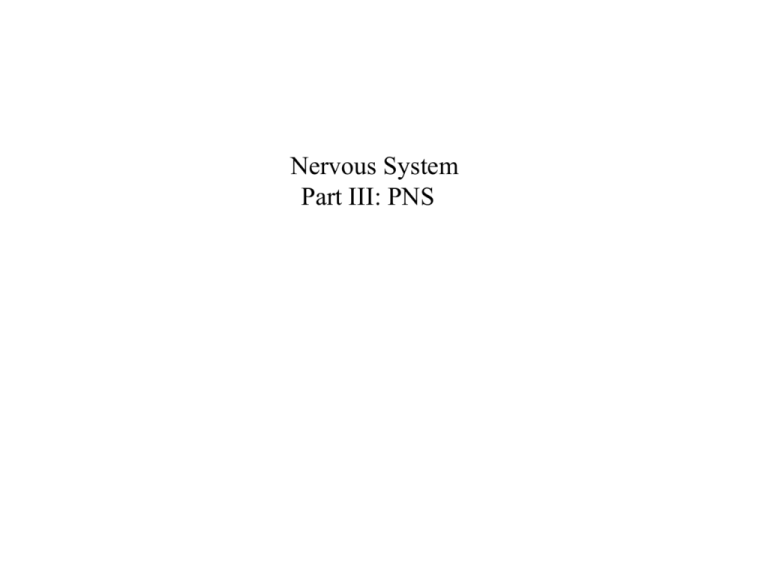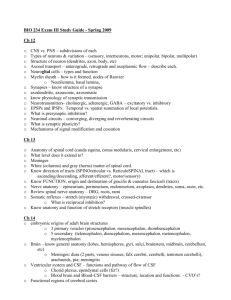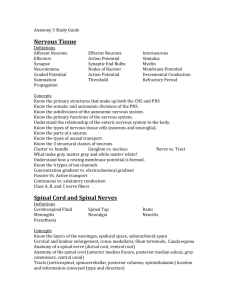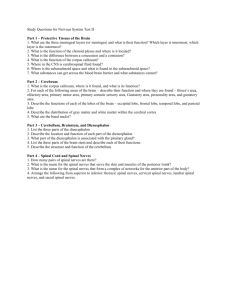Document
advertisement

Nervous System Part III: PNS I. The peripheral nervous system A. The peripheral nervous system is comprised of: 1. sense receptors-sense organs, referred to as biological transducers--a device that transfers energy, usually converting it into a different form when it does so. a. senses are; hearing, smell, sight, taste, balance, touch (a compound sense-pain, heat, cold and pressure) and senses dealing with joint position, muscle tension, blood pressure, blood pH, blood oxygen content, blood osmotic pressure, cerebrospinal-fluid pH, and others. b. senses are divided based on where they receive their stimuli. 1) exteroceptors-sense the external environment and changes in it. 2) interoceptors-unconscious senses, maintain the internal environment by sensing the changes in the internal body. 2. sensory nerves: the nerves that link receptors with the CNS. and 3. motor nerves: the nerves that link the CNS with the effectors. sense organ effector B. There are several divisions within the peripheral nervous system (PNS). 1. the somatic system-designed to keep the body in balance with the external environment, provides communication between various parts of the body and somatic effectors (skeletal muscle cells), and 2. the autonomic system-designed to maintain the internal environment, conducts impulses to visceral effectors (autonomic effectors-smooth muscle, cardiac muscle, and glandular tissue. C. somatic nervous system: 1. contains: a. receptors that react to changes in the external environment. b. the sensory neurons that keep the CNS informed of those changes, and c. the motor neurons that adjust the positions of the skeletal muscles in order to maintain the body's integrity and wellbeing. 2. sensory neurons and motor neurons- cranial and spinal nervesthese nerves carry the sensory and motor neurons of the somatic system, as well as neurons of the autonomic system. Cranial nerves Spinal nerves a. cranial nerves 1) 12 pairs of cranial nerves-10 pairs come from the brainstem, 1 pair comes from the cerebrum and 1 pair comes from the thalamus. 2) Function: a) transmit information to the brain from the special sensory receptors regarding the sense of smell, sight, hearing, and taste, and from general sensory receptors, especially in the head region, b) also bring orders from the CNS to the voluntary muscles that control movements of the eyes, face, mouth, tongue, pharynx, and larynx, c) and provide communication between the CNS and some of the internal organs. 3) designated by roman numerals and by name. names suggest their distribution or function, numbers indicate the order in which they emerge from the front to back. a) I Olfactory-sensory; smell b) II Optic-sensory; vision c) III Oculomotor-motor; eye control d) IV Trochlear-motor; movement of eye e) V Trigeminal-mixed; sensations of head and face, chewing f) VI Abducent-motor; eye movement g) VII Facial-mixed; taste; facial expression, saliva secretion h) VIII Vestibulocochlear (Acoustic)-sensory; hearing and equilibrium i) IX Glossopharyngeal-mixed; taste, swallowing; saliva secretion, blood pressure and respiration control j) X Vagus-mixed; sensations and movement of organs supplied k) XI Spinal accessory-motor movements of shoulder and head l) XII Hypoglossal-motor; tongue movements 4) gimmick: On Old Olympus Tiny Tops, A Finn And German Viewed Some Hops. 5) gimmick: Some Say Marry Money But My Brother Says Bad Business Marry Money. b. spinal nerves 1) 31 pairs of spinal nerves emerge from the spinal cord and exit out of the spinal cavity horizontally through the intervertebral foramina of their respective vertebrae. Each spinal nerve innervates a specific region of the body known as a nerve dermatome. 2) Even though each segment of the body surface is innervated by a particular spinal nerve, there is sufficient overlap so that should a nerve be injured, the segment will still be innervated by nerves that serve segments on either side of it. 3) identified by the general region of the vertebral column from which they originate, a) 8 pairs of cervical spinal nerves (C1-C8). b) 12 pairs of thoracic sn (T1-T12). c) 5 pairs of lumbar sn (L1-L5). d) 5 pairs of sacral sn (S1-S5). e) 1 pair of coccygeal sn (Co1). Nerve Dermatomes Cervical nerves C1– C8 Thoracic nerves T1-T12 Lumbar nerves L1-L5 Sacral nerves S1-S5 4) attaches indirectly by means of 2 short roots, anterior (ventral) and posterior (dorsal) roots. a) dorsal root: 1. consists of sensory (afferent) fibers. 2. there is a swelling, dorsal-root ganglion containing the cell bodies of the sensory neurons. Dorsal root Dorsal-root ganglion Cell bodies (sensory neurons) spinal nerve b) ventral root: 1. consists of motor (efferent) fibers. 2. cell bodies are found in the spinal cord, there are no ganglion here. Ventral root Motor cell bodies spinal nerve Spinal Nerve Roots Dorsal root Dorsal-root ganglion Cell bodies (sensory neurons) Ventral root Motor cell bodies spinal nerve 5) each spinal nerve exits from the vertebral column through an intervertebral foramen and is named for the vertebra immediately below that foramen. a) dorsal and ventral roots unite to form a spinal nerve in the intervertebral foramen, Dorsal root Dorsal root ganglion Ventral root Spinal nerve b) each spinal nerve divides into rami (branches). 1. dorsal ramus- fibers that innervate the muscles and skin of the dorsal portion of the body in that area. 2. ventral ramus- consists of fibers that innervate the ventral portion of the body in the area as well as the limbs. a. form plexuses (networks) with one another, each plexuses consists of interconnections of several ventral rami, these then give rise to peripheral nerves. 3.Meningeal branch- divides into 2 communicant rami that form part of the sympathetic chain ganglion. a. white rami communicants- white because they are myelinated b. gray rami communicants- gray because the fibers are not myelinated. 6) all spinal nerves are mixed or both sensory and motor. Sensory Neurons Motor Neurons Sense organs Dorsal root Dorsal root ganglion Ventral root Spinal nerve Sympathetic chain ganglion effectors Dorsal ramus Ventral ramus White ramus Gray ramus Dorsal ramus Ventral ramus White ramus Gray ramus sympathetic ganglion Gray ramus White ramus Ventral ramus Dorsal ramus body wall, muscle layers D. Autonomic system: 1. maintains a steady state within the internal environment. works automatically and without voluntary input. 2. effectors are smooth and cardiac muscle and glands. 3. the autonomic system has a series of 2 efferent neurons between the spinal cord and the effector. (the somatic system has a single efferent neuron) a. preganglionic neurons--conduct impulses before they reach a ganglion, the first to emerge from the spinal cord. b. postganglionic neurons--conduct impulses after they reach a ganglion, the second in the series. 4. The autonmonic system is subdivided into two categories. a. sympathetic system-is associated with mobilizing energy during stress situations. 1) this system operates continually, but it effects are most dramatic during emergency situations. 2) Sympathetic neurons: a) the preganglionic neurons emerge from the spinal cord through the motor roots of the thoracic and 2 lumbar spinal nerves. (thoracolumbar) 1. they pass through the white rami communicants to the paravertebral sympathetic ganglion chain. (series of ganglia located along the length of the vertebral column) most end within the ganglia and synapse with the postganglionic neurons. they innervate blood vessels and organs in the head, neck, and thoracic region. paravertebral sympathetic ganglion chain 3) some sympathetic ganglia are located a short distance from the sympathetic chain ganglia and are called collateral ganglia. a) these ganglia have their origins in the lower 6 thoracic and first 2 lumbar levels of the spinal cord. b) neurons from the collateral ganglia innervate smooth muscles and glands of the abdominal and pelvic viscera and their blood vessels.(includes organs of the digestive, urinary, and reproductive systems) 4) sympathetic effects tend to be quite widespread rather than precise, involving many organs and not just one. 5) generally, sympathetic neurons release norepinephrine (exception--neurons that innervate sweat glands generally release acetylcholine) 6) the sympathetic nervous system helps the body adjust to the continuous stresses of life. sympathetic system thoracolumbar preganglionic neuron postganglionic neuron spinal nerves sympathetic chain ganglia collateral ganglion b. parasympathetic system-usually acts to conserve and restore energy. 1) neurons emerge from the brain as part of the III, VII, IX, & X cranial nerves and from the sacral region of the spinal cord as part of the 2, 3, & 4 sacral spinal nerves. (craniosacral outflow) 2) preganglionic fibers synapse with postganglionic neurons in terminal ganglia located near or within the visceral structures that they innervate. 3) those from the cranial region innervate the eye, structures of the head, and thoracic and abdominal viscera. 4) the sacral nerves innervate the lower portion of the large intestine, urinary system and reproductive system, including the erectile tissues. 5) parasympathetic nerves do not innervate the blood vessels or sweat glands. 6) parasympathetic fibers release acetylcholine as their transmitter substance, known as a cholinergic system 7) the effects of the parasympathetic system are brief, but more precise than the sympathetic. 8) this system is most active when you are emotionally calm and physically at rest. parasympathetic system craniosacral terminal ganglion preganglionic neuron postganglionic neuron







